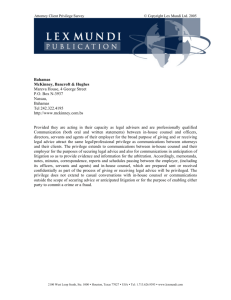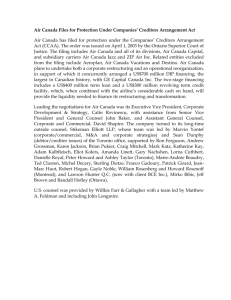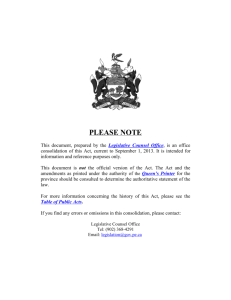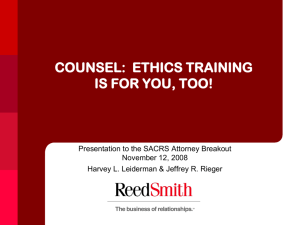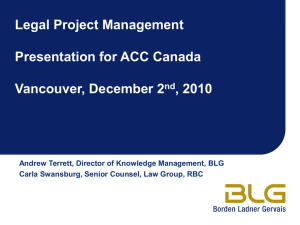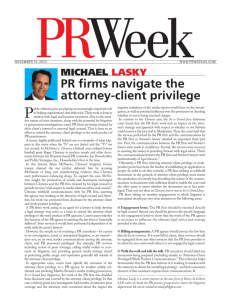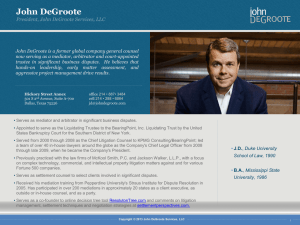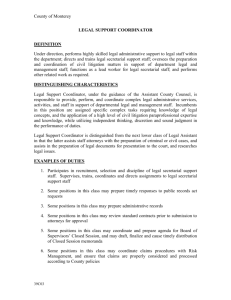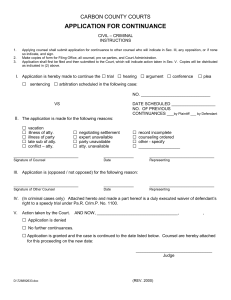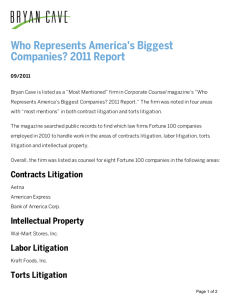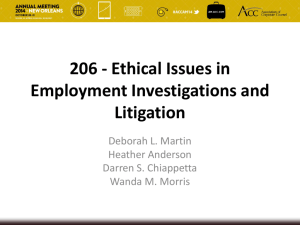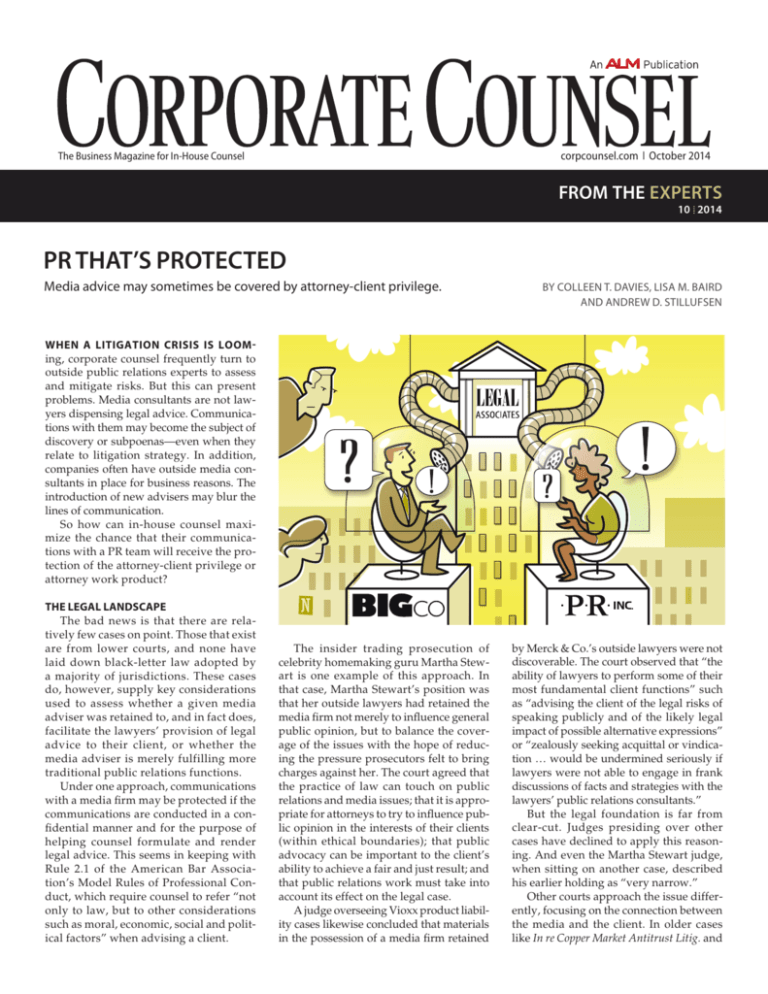
corpcounsel.com ❘ October 2014
The Business Magazine for In-House Counsel
From The Experts
10 2014
Pr that’s protected
Media advice may sometimes be covered by attorney-client privilege.
By colleen T. Davies, Lisa M. Baird
and Andrew D. Stillufsen
When a litigation crisis is looming, corporate counsel frequently turn to
outside public relations experts to assess
and mitigate risks. But this can present
problems. Media consultants are not lawyers dispensing legal advice. Communications with them may become the subject of
discovery or subpoenas—even when they
relate to litigation strategy. In addition,
companies often have outside media consultants in place for business reasons. The
introduction of new advisers may blur the
lines of communication.
So how can in-house counsel maximize the chance that their communications with a PR team will receive the protection of the attorney-client privilege or
attorney work product?
The Legal Landscape
The bad news is that there are relatively few cases on point. Those that exist
are from lower courts, and none have
laid down black-letter law adopted by
a majority of jurisdictions. These cases
do, however, supply key considerations
used to assess whether a given media
adviser was retained to, and in fact does,
facilitate the lawyers’ provision of legal
advice to their client, or whether the
media adviser is merely fulfilling more
traditional public relations functions.
Under one approach, communications
with a media firm may be protected if the
communications are conducted in a confidential manner and for the purpose of
helping counsel formulate and render
legal advice. This seems in keeping with
Rule 2.1 of the American Bar Association’s Model Rules of Professional Conduct, which require counsel to refer “not
only to law, but to other considerations
such as moral, economic, social and political factors” when advising a client.
The insider trading prosecution of
celebrity homemaking guru Martha Stewart is one example of this approach. In
that case, Martha Stewart’s position was
that her outside lawyers had retained the
media firm not merely to influence general
public opinion, but to balance the coverage of the issues with the hope of reducing the pressure prosecutors felt to bring
charges against her. The court agreed that
the practice of law can touch on public
relations and media issues; that it is appropriate for attorneys to try to influence public opinion in the interests of their clients
(within ethical boundaries); that public
advocacy can be important to the client’s
ability to achieve a fair and just result; and
that public relations work must take into
account its effect on the legal case.
A judge overseeing Vioxx product liability cases likewise concluded that materials
in the possession of a media firm retained
by Merck & Co.’s outside lawyers were not
discoverable. The court observed that “the
ability of lawyers to perform some of their
most fundamental client functions” such
as “advising the client of the legal risks of
speaking publicly and of the likely legal
impact of possible alternative expressions”
or “zealously seeking acquittal or vindication … would be undermined seriously if
lawyers were not able to engage in frank
discussions of facts and strategies with the
lawyers’ public relations consultants.”
But the legal foundation is far from
clear-cut. Judges presiding over other
cases have declined to apply this reasoning. And even the Martha Stewart judge,
when sitting on another case, described
his earlier holding as “very narrow.”
Other courts approach the issue differently, focusing on the connection between
the media and the client. In older cases
like In re Copper Market Antitrust Litig. and
From The Experts
10 2014
more recent ones like Hadjih v. Evenflo, the
issue has turned on whether the media firm
is the functional equivalent of a corporate
employee, performing an essential corporate function necessitated by a government
investigation or litigation and resulting
from the need for legal advice.
Cases in which courts have allowed discovery of communications with media consultants also are instructive, because they
provide guidance on what not to do. For
example, in recent litigation related to the collapse of the Interstate 35 bridge in Minnesota,
the court was asked to protect communications between the defendant company and a
public relations firm it hired in the wake of
the accident. It refused because the company
had a long-standing relationship with the
media firm prior to the accident, and because
the advice provided did not “rise to the level
of communications made for the purpose of
giving or receiving legal advice.”
colleen t. davies
lisa m. baird
that communications with the public relations firm would not have been privileged
had Stewart hired the firm directly, even if
the retention had the same purpose. And
the NXIVM case makes clear that courts
will see through retentions that fail to
actually support the legal purpose.
One approach says communications may be protected if they’re
for the purpose of helping counsel render legal advice.
In NXIVM v. O’Hara, the court similarly
concluded that the media firm was not
retained to assist the company in providing legal advice. Even though that was the
stated purpose for the retention, the attorney
had little involvement in communications
after the contract was signed. And in Calvin
Klein Trademark Trust v. Wachner, the court
required the disclosure of certain documents
as well. In part this was because the media
firm also performed routine public relations
work (and thus did not only help the lawyers in providing legal advice), and in part
this was because some documents were not
kept confidential in the first place.
Practice Tips
Inside counsel can maximize the chance
that a court will recognize as privileged
communications with a media firm by following these six tips:
1. The reason for hiring a media firm for
current or threatened litigation must be different than the reason for hiring a media
firm for everyday PR work. The purpose
must be to facilitate counsel’s provision of
legal advice, and the contract with the public
relations firm should spell it out.
2. Wherever possible, the company’s
outside law firm should retain the litigation public relations firm, and then stay
directly involved. Retention of the media
firm by the lawyers was critical in the Martha Stewart case, where the court stated
3. The media firm should, if possible,
be different from the company’s ordinary
PR firm. This will minimize the chance
that work related to the provision of legal
advice will mix with ordinary work, leading to protection for none of it. In fact, consider a public relations firm specializing in
crisis management to improve the odds that
the company and its counsel will get the
media advice needed, with the proper level
of attention given to confidentiality and the
legal purpose behind the retention.
4. If the company must continue
with the same media firm for litigationrelated work used for everyday work,
both sides should take steps to keep
the engagements separate and the litigation-related work confidential. This
should include a new engagement letter, separate billing and walling off of
files and employees. Setting up a separate working team specifically for legal
communications is helpful.
5. Counsel and the media firm should
prepare and follow a strict protocol
regarding document confidentiality. It
should include:
Having counsel involved in drafting
documents and communicating with the
media firm;
Marking privileged communications “Privileged and Confidential” and
subject to the attorney-client privilege or
work product protection (if applicable);
andrew d. stillufsen
Advising document recipients to
limit dissemination. Since this is not
always instinctive to corporate employees or media advisers, ongoing counsel is
important on this point;
Including an explanation of how the
document pertains to the provision of
legal advice; and
Having the media firm submit its bills
directly to the attorney, with generalized
entries that can facilitate a privilege review
should it be needed. Compliance may be
improved if the consequences are specified
in advance: that the media firm will be dismissed and responsible for any damages if
it violates the protocol.
6. The public relations firm and its
employees should sign an agreement
that outlines confidentiality obligations,
and notes that any inadvertent disclosure will not waive privilege and workproduct protections.
While media communications during
a crisis are always fast-moving, a corporate counsel’s proactive attention to these
tips on the front end can make all the difference in preserving privilege at a later
date, should litigation arise.
Colleen T. Davies is a member of Reed Smith’s senior
management team and a partner in the firm’s product
liability group. She advises on media relations, crisis
management, product warnings, design development,
claims management and product recalls. Lisa M. Baird
is counsel in the firm’s life sciences health industry
group. She has deep trial court and appellate experience
dealing strategically with product liability and complex
litigation. Andrew D. Stillufsen is a senior asso­ciate at
the firm focusing on pharmaceutical and medical device
product liability, with specialization in attorney-client
privilege and the work product doctrine.
Reprinted with permission from the October 2014 edition of
Corporate Counsel © 2014 ALM Media Properties,
LLC. All rights reserved. Further duplication without
permission is prohibited. For information, contact
877-257-3382 or reprints@alm.com. # 016-09-14-08

